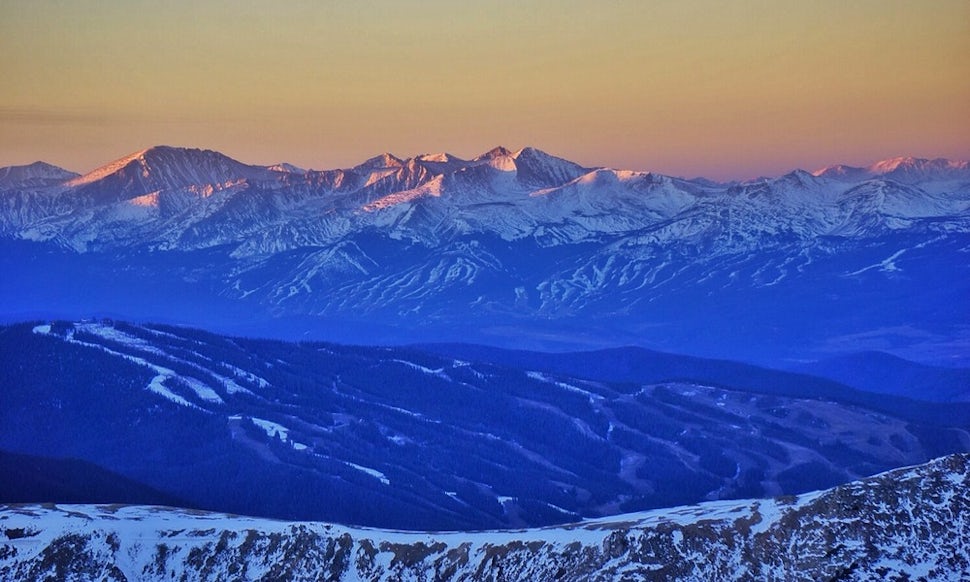Three 13ers to Tackle This Winter

When people think of the pristine snow-capped peaks of a Colorado winter, they generally think of skiing. But whether you need a break from the skiing, a break from the traffic and crowds, or there’s just a break in the weather, climbing one of Colorado’s many 13ers will break up your routine a little. When mild weather deteriorates conditions on the slopes, chances are, it’s excellent hiking weather. It’s time to dig out your hiking boots and bag a few peaks while you wait for the next storm. Check out these three awesome 13ers within an hour’s drive from Denver.
Grizzly Peak (13,427’)
- Distance: 6 miles round-trip
- Difficulty: Strenuous
- Duration: 4-6 hours
- Elevation Gain: 2900 feet
While Grizzly Peak shares a trailhead with Mt. Sniktau at Loveland Pass, these are two very different hikes. Mt. Sniktau is a good introduction to winter hiking, while Grizzly Peak is favorite among seasoned winter hikers and skiers. It’s an ideal summit for those who don’t have the time to drive deep into the mountains but want a solidly challenging hike. Riddled with false summits, a Class 2 scramble, and wicked wind, this more difficult hike is rewarded with phenomenal views of Torreys and Grays Peaks right next door, Chihuahua Gulch, as well as Lenawee and the other well-loved peaks rimming Arapahoe Basin Ski Area. Because of its prominence, the view from Grizzly Peak on a clear day is endless. While the relentless wind makes snowshoes unnecessary, the steep grade of the last 650 vertical feet requires microspikes or hiking crampons.
Inside Tip: While Torreys Peak (14,267’) looks near enough to touch, it is another 3 miles and 2400’ ascent round-trip; a good challenge for the well-prepared mountaineer.
Mt. Sniktau (13,234’)
- Distance: 4 miles round-trip
- Duration: 2-3 hours
- Difficulty: Easy
- Elevation Gain: 1300 feet
This impressive-looking mountain towers over I-70 as you approach the Eisenhower Tunnel. Don’t be fooled by its imposing north face, however; the hike from Loveland Pass to the summit is a fairly easy 2-mile trek along the southwest ridge. The most difficult part is gaining nearly 1000 feet in the first mile. After that, you will encounter a false summit of over 13,000 feet, but overall it is a very easy mile to the summit of Mt. Sniktau. The hike begins at 12,000, so you are above the trees with unimpeded views for the entire hike. From the top is an incredible vista of Torreys and Grays Peaks nearby, ski areas to the southwest (A-Basin, Keystone, and Breckenridge), and more of the Continental Divide to the north. Microspikes and warm boots are sufficient footgear for this wind-swept terrain.
Inside Tip: This is a fabulous location for a sunrise/sunset photo shoot, poised for catching the wide-open skies, alpenglow on the surrounding peaks, and long exposures of I-70 traffic.
James Peak (13,294’)
- Distance: 8.3 miles round-trip
- Difficulty: Moderate – Strenuous
- Duration: Full day
- Elevation Gain: 3000 feet
Occupying 17,015 acres adjacent to and east of the Continental Divide, James Peak Wilderness is named for its most prominent mountain, James Peak. There are several ways to approach James Peak, but hiking via St. Mary’s Glacier (a beautiful place in its own right) will afford you the option of skiing, snowboarding, or glissading down the snowfields on the return. While it begins with a steep ascent that may require snowshoes in winter, it flattens out at the top of the glacier where the impressive profile of James Peak rises up. Another climb approaching the summit, and you’ll be rewarded with long-ranging views of the Continental Divide, including 14ers Mt. Evans, Torreys Peak, and Grays Peak. Additionally, you may see a number of lakes in the gulches and valleys, depending on their frozen state. As with most winter hikes, you may have to rely on cairns to guide your way when the snow covers the trail.
Inside Tip: St. Mary’s Glacier is a good place to practice your winter mountaineering skills when you’re not hiking.
As always, exercise caution and common sense when hiking in the winter. Be prepared for adverse weather conditions, carry plenty of food and water, invest in the proper gear, and never push on when conditions are deteriorating.
We want to acknowledge and thank the past, present, and future generations of all Native Nations and Indigenous Peoples whose ancestral lands we travel, explore, and play on. Always practice Leave No Trace ethics on your adventures and follow local regulations. Please explore responsibly!
Do you love the outdoors?
Yep, us too. That's why we send you the best local adventures, stories, and expert advice, right to your inbox.











